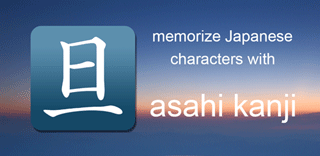

Asahi Kanji (English) application for iOS (iPhone / iPod Touch / iPad)
and Asahi JLPT-N5
![]() Short description
Short description
A tool for reviewing and memorizing Japanese characters, ordered according to the 5 levels of the Japanese Language Proficiency Test (N5 to N1), or the Jōyō Kanji.
![]() System requirement:
System requirement:
Compatibility: Requires iOS 7.1 or later. Compatible with iPhone, iPad, and iPod touch. This app is optimized for iPhone 5, iPhone 6, and iPhone 6 Plus.
![]() Contact:
Contact:
Developer: Roger Meyer support@japanese-kanji.com
![]() Features
Features
- A typical stack of flashcards for all Jōyō kanji (2141 kanji, 2010 official list) and the 5 levels of the Japanese Language Proficiency Test (N5 to N1).
Display can be toggled on and off for all panels (kanji, meanings, On-yomi, Kun-yomi and sample compounds. - Choice of the JLPT or Jōyō Kanji order.
- Six multiple choice drills or tests on meanings, On-yomi (Chinese readings) and Kun-yomi (Japanese readings)
- Choice of the range of kanji you want to concentrate on.
- Possibility to mark known kanji in order to exclude them from the tests.
- Repeat (a stack of cards populated with the wrong answers from the tests)
- Report displaying your score for each test.
![]() Reading actual texts is by far the best way to learn the written language,
but flashcard programs have always been useful tools.
Reading actual texts is by far the best way to learn the written language,
but flashcard programs have always been useful tools.
This iPhone app will help you get a sense of how much you already know, brush up on your Japanese, and prepare for a test.
We also believe that a certain amount of rote learning is a necessity when it comes to studying the kanji.
This app was thus conceived as a reviewing tool or a memorization tool.
It is designed for students who have already started to learn Japanese. It is
therefore assumed that you can read katakana and hiragana signs.
This application is the iPhone version of the Java applet "Memorize Japanese kanji" that has been freely available since 2001 at
https://www.asahi-net.or.jp/~ik2r-myr/kanji/kanji1a.htm
This application should help you
- evaluate your present level
- brush up on your knowledge of Japanese kanji
- help you memorize new characters
![]() Radicals (bushu 部首) and elements
Radicals (bushu 部首) and elements
A list of 259 radicals and elements, a flashcards stack and four multiple choice drills. For more details, please read the specific presentation page:
https://www.japanese-kanji.com/ios/english/radicals-bushu-ios.htm
![]() The Flashcards
The Flashcards
Depending on your choice in the panel "Kanji range selection", these flashcards will follow the Jōyō Kanji order or the order of the five levels of the
Japanese Language Proficiency Test
For a more detailed explanation of these orders and levels, please read the specific page levels-jlpt.
The database contains all 2136 Jōyō kanji (regular-use characters) of the official list issued in 2010 by the Japanese Ministry of Education.
+ five from the previous list.
Each card displays a kanji, its meaning(s), its common On and Kun readings and up to three compound
examples.
You can toggle the visibility of items on the cards with a touch on the various panels.
Suggestion on how to use the flashcards:
- In the Kanji range selection panel Select the range of kanji you want to concentrate on.
- In the Flashcards panel hide the meanings and examples and flip through the cards.
If you think you know the displayed kanji, mark it as "known" with a touch on the +/- icon (toggle).
Kanji marked as "known" will be excluded from the On, Kun and Meanings drills/exercises, until you reset them to the "unknown" state, either individually or in a batch in the Settings panel.
Your choices will be saved in the database and you can safely turn off your iPhone/iPod/iPad.
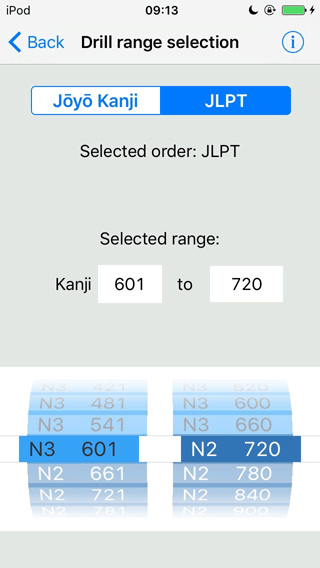
![]() The drills / tests or exercises
The drills / tests or exercises
The application offers six types of multiple choice questions or tests (MCQ).
You are asked to choose between four characters, meanings or readings.
The interface is optimized for small devices like the iPhone and iPod Touch, as you can hold them in one hand and cover the whole screen with the thumb.
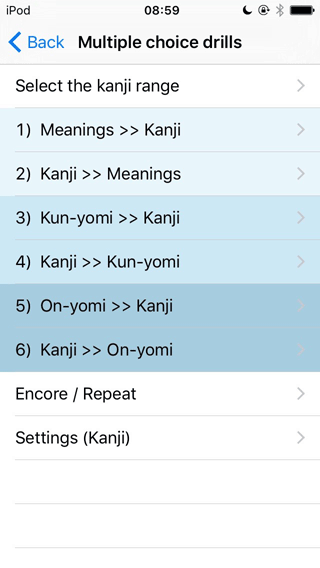
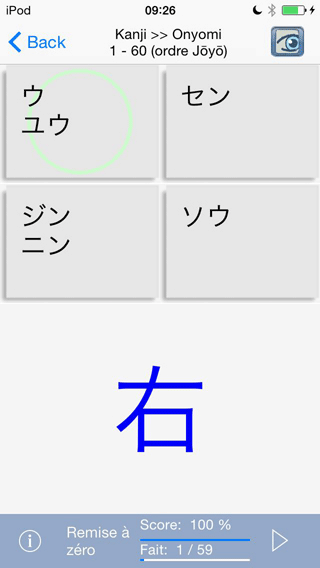
Whenever you make a mistake, you can have a look at the corresponding card with a touch on the eye icon .
You can do the same with the correct answer, display the corresponding card and mark the kanji as known if you wish to exclude it from future exercises.
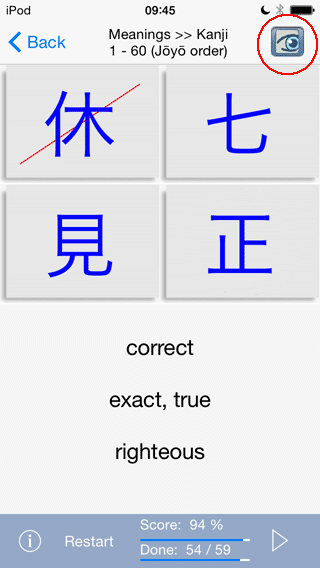
![]() Encore! / Review
Encore! / Review
In the "Review" stack, you will find
kanji you should concentrate on.
As you go through the drills, the program memorizes the wrong choices you made,
together with the kanji you should have chosen.
The behavior of the cards is the same as in the Flashcards / Review stack : you will be
able to hide or display the meanings and examples with a touch on the panels (toggle).
You can also mark kanji as "known" in order to exclude them from future tests, until you reset them to the "unknown" state.
The cards in the Encore stack are displayed in an endless loop, whether you use the Next or Previous buttons.
The Reset button enables you to empty the Encore!/Review stack of cards.
![]() Report
Report
The Report panel displays the results of completed drills only.
In this version your scores are not saved automatically. If the application is killed by the system when it needs more memory for another task,
the displayed data will be erased.
Therefore, if you wish to keep track of your progress, you must save your scores
as an email message. Asahi Kanji will launch your default mail program and populate a message with your results.
You can save this message as a draft on your device or send it to yourself.
This application has no access to your address book and you will have to fill in the mailing address yourself.
![]() Settings
Settings
In the Flashcard and Encore!/Repeat drills you can mark or unmark cards as "known" with a tap on the +/- icon.
Cards marked as known are then excluded from the drills.
In this version "settings" are limited to resetting "known" kanji to the "unknown" state and emptying the Encore!/Repeat stack of cards.
After you reset the whole stack of cards to the "unknown" state, all kanji will again be included in the drills.
![]() iPad (all models)
iPad (all models)
The interface is more adapted to small devices like the iPhone and iPod Touch, as you can go through the exercises using only one hand.
On the other hand, tablets like the iPad offer the possibility to run the app in full-screen mode, which improves both legibility and readability.
![]() Memory management
Memory management
You can leave an uncompleted drill and switch to another application. When you reopen Asahi Kanji you will be able to resume any unfinished drill where you have left it.
When a drill is completed it is automatically reinitialized when you return to the Top menu.
Please note:
A modification of the range of kanji, the marking or unmarking of a card as "known" reinitializes unfinished exercises in order to keep scores and progress coherent.
![]() On and Kun readings
On and Kun readings
As is customary, On readings (the Chinese readings or on-yomi)
are given in katakana and Kun readings (the Japanese readings or
kun-yomi) in hiragana.
If a kanji is a verb stem, the inflectional endings
(usually written in hiragana after the kanji) are shown in parenthesis.
A kanji may have many meanings or interpretations. Due to lack of space, only the most common meanings are
shown. One to three examples are given for each kanji. These examples can be
either common compounds or common expressions. We limited ourselves to frequent
compounds or uses of the kanji, which explains the blanks.